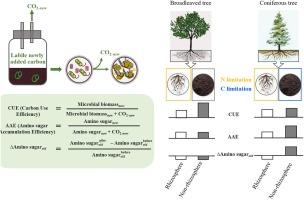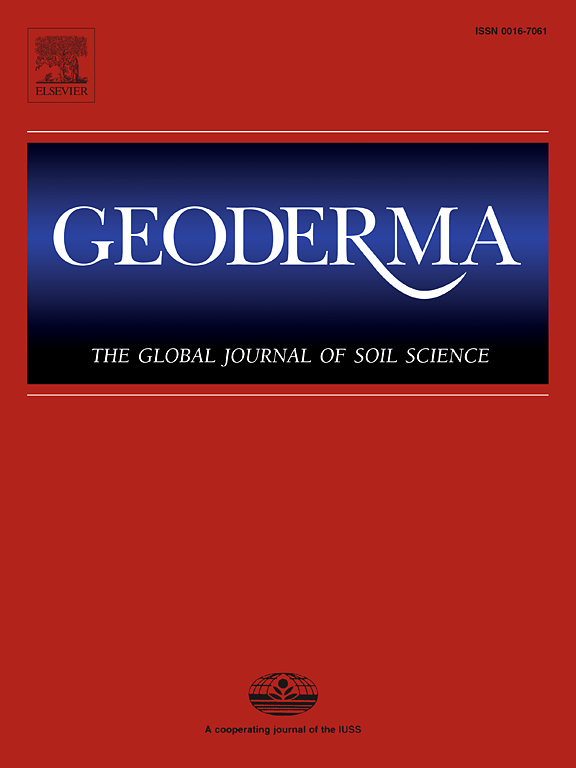阔叶树和针叶树根瘤菌圈与非根瘤菌圈中新增加的可溶性土壤碳和原生土壤碳所产生的微生物坏死累积量
IF 5.6
1区 农林科学
Q1 SOIL SCIENCE
引用次数: 0
摘要
微生物介导的碳(C)转化在土壤有机碳(SOC)积累过程中起着至关重要的作用。然而,微生物将新增加的可变碳和本地 SOC 转化为坏质的效率仍未得到充分研究。在此,我们采集了不同养分供应情况下阔叶树和针叶树下的根圈和非根圈土壤,并用 13C 标记的葡萄糖进行了为期 80 天的土壤培养,以评估 "微生物碳泵"(MCP)能力(新的 C 衍生生物量和新生物量)、基于磷脂脂肪酸(PLFAs)的 C 利用效率(即、CUE′,以区别于基于微生物生物量 C 的 CUE)和氨基酸糖(反映坏死物质)积累效率(AAE;相对于呼吸作用的新 C 衍生氨基酸糖)。我们发现 MCP 能力、微生物 AAE 和 CUE′具有不同的变化规律和影响因素。添加的葡萄糖量对 MCP 能力起着决定性作用。预测 AAE 的关键因素是无机氮(N)与添加的葡萄糖之比(反映 N 限制)和细菌 PLFAs,而真菌与细菌之比和 C 与 N 之比则是预测 CUE′ 的重要因素。此外,我们还发现,在碳限制而非氮限制的土壤(AAE 高)中,添加葡萄糖可刺激微生物将原生 SOC 转化为坏死物质,而不会产生引物效应,这可能会增强微生物介导的 SOC 固碳作用。这些研究结果表明,微生物新陈代谢积累的效率受到氮供应量的强烈影响,与生物量合成脱钩,凸显了养分通过植物-微生物相互作用对 SOC 固碳的调节作用。我们认为,AAE 是评估由可溶性 C 推动的 MCP 效率的更可靠指标。本文章由计算机程序翻译,如有差异,请以英文原文为准。

Microbial necromass accrual from newly added labile and native soil carbon in the rhizosphere vs. non-rhizosphere of broadleaved and coniferous trees
Microbe-mediated carbon (C) transformation plays a crucial role in the accumulation of soil organic C (SOC). However, microbial conversion efficiency of newly-added labile C and native SOC to necromass remain under-investigated. Here we collected the rhizosphere and non-rhizosphere soils under broadleaved and coniferous trees of varying nutrient availability, and conducted an 80-day soil incubation with 13C-labelled glucose to evaluate ‘microbial C pump’ (MCP) capacity (new C-derived biomass and necromass), phospholipid fatty acids (PLFAs)-based C use efficiency (i.e., new C-derived PLFAs relative to respiration, referred as CUE′ to differentiate from microbial biomass C-based CUE) and amino sugar (reflecting necromass) accumulation efficiency (AAE; new C-derived amino sugars relative to respiration). We found that MCP capacity, microbial AAE and CUE′ had different variation patterns and influencing factors. The amount of added glucose played a decisive role in determining MCP capacity. The key predictors of AAE were the ratio of inorganic nitrogen (N) to added glucose (reflecting N limitation) and bacterial PLFAs, while ratios of fungi to bacteria and C to N were important for predicting CUE′. Furthermore, we found that glucose addition stimulated microbial transformation of native SOC into necromass in C- but not N-limited soils (with a high AAE) without invoking a priming effect, potentially enhancing microbe-mediated SOC sequestration. These findings suggest that the efficiency of microbial necromass accumulation is strongly influenced by N availability and decoupled from biomass synthesis, highlighting nutrient regulations on SOC sequestration via plant–microbe interactions. We argue that AAE is a more reliable indicator to assess the efficiency of MCP fueled by labile C.
求助全文
通过发布文献求助,成功后即可免费获取论文全文。
去求助
来源期刊

Geoderma
农林科学-土壤科学
CiteScore
11.80
自引率
6.60%
发文量
597
审稿时长
58 days
期刊介绍:
Geoderma - the global journal of soil science - welcomes authors, readers and soil research from all parts of the world, encourages worldwide soil studies, and embraces all aspects of soil science and its associated pedagogy. The journal particularly welcomes interdisciplinary work focusing on dynamic soil processes and functions across space and time.
 求助内容:
求助内容: 应助结果提醒方式:
应助结果提醒方式:


